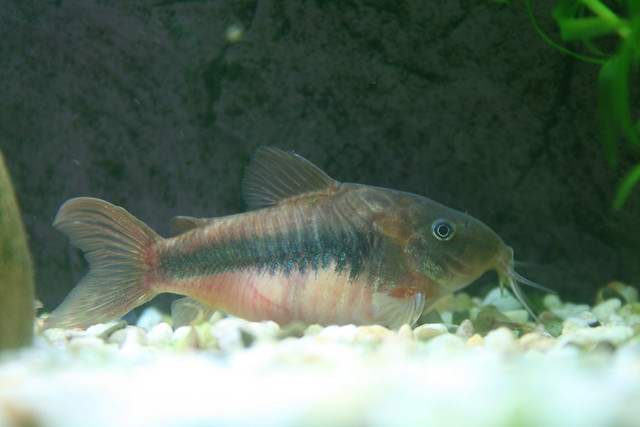 |
| Photo by h080 |
The female is a little bigger than the male, but the shape is a better way of telling the sexes apart. The female gets a bigger belly, and if looked at from above the female is clearly wider than the male.
The male has a longer and more pointed dorsal fin.
Breeding
The bronze Catfish is probably the easiest fish of its genus to breed. The parents to be should be well fed for a while before breeding. It is common to use two males and one female for breeding. In the wild, this species will breed at the start of the breeding season. A drop in water temperature will often stimulate the breeding. This drop can be as much as 4 degrees C. Some people go further and lower the temperature by sprinkling cooler water over the surface of the water to simulate heavy rain. This fish is an egg placer. The female carefully cleans a number of places for the eggs. These places may be on the sides of the aquarium, or on the leaves of plants.
is probably the easiest fish of its genus to breed. The parents to be should be well fed for a while before breeding. It is common to use two males and one female for breeding. In the wild, this species will breed at the start of the breeding season. A drop in water temperature will often stimulate the breeding. This drop can be as much as 4 degrees C. Some people go further and lower the temperature by sprinkling cooler water over the surface of the water to simulate heavy rain. This fish is an egg placer. The female carefully cleans a number of places for the eggs. These places may be on the sides of the aquarium, or on the leaves of plants.
When they are ready the breeders assume the "T" position with the female's mouth adjacent to the male's vent. The female takes the male's sperm into her mouth ready for fertilization. She lays her eggs into a little basket formed by her pectoral fins and carefully places the fertilized eggs onto the prepared places.
The number of eggs laid each time varies between 1 and 10. The breeders repeat this until the female has laid all her eggs. This may be up to 300 eggs and the spawning will sometimes take several days.
When they are first laid the eggs are nearly clear, but they darken to a golden brown. If they turn white they are infertile. Infertile eggs get fungus which can spread to healthy eggs. Generally, the eggs are separated from the parents because some people have observed Bronze Catfish eating their own eggs and young. The eggs hatch in about 5 days.
Fertilisation
The method of fertilization used by many corydoras catfish is in dispute. The old idea was that the sperm goes very quickly through the female's digestive tract and comes out of her vent in exactly the right position to fertilize the eggs. It has always been recognized that there were problems with this theory. The sperm would have to pass through much faster than food normally does, and avoid being digested. Various ways were postulated to explain how this is done.
Another idea is that the sperm comes out of the gill covers of the female and are directed backward in the right general direction to fertilize the eggs. Reading forums, you can see that there are people who adamantly insist that one or other of the theories are correct. The supporters of both sides are experienced breeders who have carefully observed the spawning of Bronze Catfish . Personally, I think the second theory is more likely to be correct.
. Personally, I think the second theory is more likely to be correct.
Raising the Fry
After hatching the babies will live on their yolk sac for 2 or 3 days. They will then eat infusoria and fine fry food including Microworms and other very small live food.
Steve Challis has many other fish fact sheets and other articles on http://www.bettatrading.com.au including a fact sheet about the Bristlenose Catfish at http://www.bettatrading.com.au/Bristlenose-Catfish-Fact-Sheet.php.
Article Source: EzineArticles
|

No comments:
Post a Comment